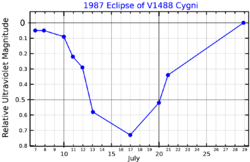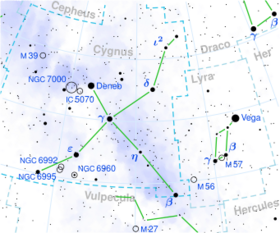Astronomy:32 Cygni
| Observation data Equinox J2000.0]] (ICRS) | |
|---|---|
| Constellation | Cygnus |
| Right ascension | 20h 15m 28.32289s[1] |
| Declination | +47° 42′ 51.1609″[1] |
| Apparent magnitude (V) | 3.98[2] (3.90 - 4.14[3]) |
| Characteristics | |
| Spectral type | K5 Iab + B7 V[4] |
| U−B color index | +1.03[2] |
| B−V color index | +1.52[2] |
| Variable type | EA[3] |
| Astrometry | |
| Radial velocity (Rv) | −14.4[5] km/s |
| Proper motion (μ) | RA: +1.892[6] mas/yr Dec.: +2.810[6] mas/yr |
| Parallax (π) | 2.12 ± 0.30[6] mas |
| Distance | approx. 1,500 ly (approx. 470 pc) |
| Absolute magnitude (MV) | −3.56[7] |
| Orbit[8] | |
| Period (P) | 1,147.8 days |
| Semi-major axis (a) | 5.50±1.20 mas |
| Eccentricity (e) | 0.300 |
| Inclination (i) | 65.50±8.30° |
| Periastron epoch (T) | 2433141.8 HJD |
| Argument of periastron (ω) (secondary) | 218.20° |
| Details | |
| 32 Cyg A | |
| Mass | 7.45[9] M☉ |
| Radius | 277[10] R☉ |
| Luminosity | 16,600 - 17,540[10] L☉ |
| Surface gravity (log g) | 0.78[9] cgs |
| Temperature | 3,986±170[10] K |
| Metallicity [Fe/H] | −0.43[11] dex |
| Age | < 20[12] Myr |
| 32 Cyg B | |
| Mass | 4.13[9] M☉ |
| Radius | 3.0[9] R☉ |
| Luminosity | 302[9] L☉ |
| Temperature | 16,200[13] K |
| Other designations | |
| A: HD 192909 | |
| B: HD 192910 | |
| Database references | |
| SIMBAD | 32 Cyg |
32 Cygni (32 Cyg, Omicron2 Cyg, ο2 Cyg) is the Flamsteed designation for a binary star system in the Cygnus constellation. It is a 4th magnitude star, which can be seen with the naked eye under suitably dark skies. Parallax measurements give an estimated distance of 1,100 light-years (320 parsecs) from the Earth.[1] However, Schröder et al. (2007) suggest the actual value, after correcting for Malmquist bias, may be closer to 1,174 light-years (360 parsecs).[9] Although it is a spectrsocopic binary with components that cannot be separated visually, it has two entries in the Henry Draper Catalogue, with identical magnitudes and positions, but showing the spectral types of the two components.[15]
The Bayer letter ο has been variously applied to two or three of the stars 30, 31, and 32 Cygni. 32 Cygni has been designated as either ο2 or ο3 Cygni. For clarity, it is preferred to use the Flamsteed designation 32 Cygni rather than one of the Bayer designations.[14]
The primary component in this system, 32 Cygni A, has a stellar classification of K5 Iab, indicating that it is a supergiant star. Its effective temperature of 3,840 K lies in the range for K-type stars,[9] giving it an orange hue.[16] This star has over seven times more than the mass of the Sun and the outer envelope has expanded to about 184 times the Sun's radius.[9] It is radiating 6,600 times the luminosity of the Sun.[9]
32 Cygni B, the companion star, is three times as luminous as the Sun and four times as massive.[9] It has a much higher effective temperature of 16,200 K[13] and is radiating over 300 times the Sun's luminosity.[9] This star has the blue-white hue of a B7 star main sequence star.

The two stars form an eclipsing binary system (variable star designation: V1488 Cyg) similar to Algol. The orbital plane of the two stars is nearly aligned with the line of sight from the Earth, so that the supergiant star eclipses the secondary component once per orbit. During an eclipse, emission lines can be seen in the spectrum of this system. These originate in the stellar wind escaping from the supergiant star. In a volume around the B star, this wind becomes ionized, resulting in a circumstellar H II region.[18] The supergiant star is losing mass at the rate of 1.3×10−8 times the mass of the Sun per year, or the equivalent of the Sun's mass every 77 million years.[9]
The Washington Double Star Catalog and Catalog of Components of Double and Multiple Stars both list a visual companion 208" distant. This star is the 8th magnitude A class HD 192933.[19][20]
References
- ↑ 1.0 1.1 1.2 van Leeuwen, F. (November 2007), "Validation of the new Hipparcos reduction", Astronomy and Astrophysics 474 (2): 653–664, doi:10.1051/0004-6361:20078357, Bibcode: 2007A&A...474..653V.
- ↑ 2.0 2.1 2.2 Johnson, H. L. et al. (1966), "UBVRIJKL photometry of the bright stars", Communications of the Lunar and Planetary Laboratory 4 (99): 99, Bibcode: 1966CoLPL...4...99J.
- ↑ 3.0 3.1 Samus, N. N. et al. (2009). "VizieR Online Data Catalog: General Catalogue of Variable Stars (Samus+ 2007-2013)". VizieR On-line Data Catalog: B/GCVS. Originally Published in: 2009yCat....102025S 1. Bibcode: 2009yCat....102025S.
- ↑ Eggleton, P. P.; Tokovinin, A. A. (2008). "A catalogue of multiplicity among bright stellar systems". Monthly Notices of the Royal Astronomical Society 389 (2): 869. doi:10.1111/j.1365-2966.2008.13596.x. Bibcode: 2008MNRAS.389..869E.
- ↑ Wilson, Ralph Elmer (1953), "General catalogue of stellar radial velocities", Washington (Carnegie Institution of Washington), Bibcode: 1953GCRV..C......0W.
- ↑ 6.0 6.1 6.2 Brown, A. G. A. (August 2018). "Gaia Data Release 2: Summary of the contents and survey properties". Astronomy & Astrophysics 616: A1. doi:10.1051/0004-6361/201833051. Bibcode: 2018A&A...616A...1G. Gaia DR2 record for this source at VizieR.
- ↑ Anderson, E.; Francis, Ch. (2012). "XHIP: An extended hipparcos compilation". Astronomy Letters 38 (5): 331. doi:10.1134/S1063773712050015. Bibcode: 2012AstL...38..331A.
- ↑ Jancart, S. et al. (October 2005), "Astrometric orbits of SB^9 stars", Astronomy and Astrophysics 442 (1): 365–380, doi:10.1051/0004-6361:20053003, Bibcode: 2005A&A...442..365J.
- ↑ 9.00 9.01 9.02 9.03 9.04 9.05 9.06 9.07 9.08 9.09 9.10 9.11 Schröder, K.-P.; Cuntz, M. (April 2007), "A critical test of empirical mass loss formulas applied to individual giants and supergiants", Astronomy and Astrophysics 465 (2): 593–601, doi:10.1051/0004-6361:20066633, Bibcode: 2007A&A...465..593S.
- ↑ 10.0 10.1 10.2 Messineo, M.; Brown, A. G. A. (2019). "A Catalog of Known Galactic K-M Stars of Class I Candidate Red Supergiants in Gaia DR2". The Astronomical Journal 158 (1): 20. doi:10.3847/1538-3881/ab1cbd. Bibcode: 2019AJ....158...20M.
- ↑ Cenarro, A. J. et al. (January 2007), "Medium-resolution Isaac Newton Telescope library of empirical spectra - II. The stellar atmospheric parameters", Monthly Notices of the Royal Astronomical Society 374 (2): 664–690, doi:10.1111/j.1365-2966.2006.11196.x, Bibcode: 2007MNRAS.374..664C.
- ↑ Kaler, James B., "OMI-2 CYG (Omicron-2 = 32 Cygni)", Stars (University of Illinois), http://stars.astro.illinois.edu/sow/omi2cyg.html, retrieved 2012-01-20.
- ↑ 13.0 13.1 Malkov, O. Yu. (December 2007), "Mass-luminosity relation of intermediate-mass stars", Monthly Notices of the Royal Astronomical Society 382 (3): 1073–1086, doi:10.1111/j.1365-2966.2007.12086.x, Bibcode: 2007MNRAS.382.1073M.
- ↑ 14.0 14.1 Kostjuk, N. D. (2004). "VizieR Online Data Catalog: HD-DM-GC-HR-HIP-Bayer-Flamsteed Cross Index (Kostjuk, 2002)". VizieR On-line Data Catalog: IV/27A. Originally Published in: Institute of Astronomy of Russian Academy of Sciences (2002) 4027. Bibcode: 2004yCat.4027....0K.
- ↑ Nesterov, V. V.; Kuzmin, A. V.; Ashimbaeva, N. T.; Volchkov, A. A.; Röser, S.; Bastian, U. (1995). "The Henry Draper Extension Charts: A catalogue of accurate positions, proper motions, magnitudes and spectral types of 86933 stars". Astronomy and Astrophysics 110: 367. Bibcode: 1995A&AS..110..367N.
- ↑ "The Colour of Stars", Australia Telescope, Outreach and Education (Commonwealth Scientific and Industrial Research Organisation), December 21, 2004, http://outreach.atnf.csiro.au/education/senior/astrophysics/photometry_colour.html, retrieved 2012-01-16.
- ↑ Dolzan, A. (November 1987). "32 Cyg: UBV Photometry of Eclipse in 1987". Information Bulletin on Variable Stars 3112: 1. Bibcode: 1987IBVS.3112....1D. https://ui.adsabs.harvard.edu/abs/1987IBVS.3112....1D. Retrieved 27 December 2021.
- ↑ Eaton, J. A. (November 2008), "Emission Lines in 32 Cygni", The Journal of Astronomical Data 14: 3, Bibcode: 2008JAD....14....3E.
- ↑ Mason, Brian D.; Wycoff, Gary L.; Hartkopf, William I.; Douglass, Geoffrey G.; Worley, Charles E. (2001). "The 2001 US Naval Observatory Double Star CD-ROM. I. The Washington Double Star Catalog". The Astronomical Journal 122 (6): 3466. doi:10.1086/323920. Bibcode: 2001AJ....122.3466M.
- ↑ Dommanget, J.; Nys, O. (1994). "Catalogue des composantes d'etoiles doubles et multiples (CCDM) premiere edition - Catalogue of the components of double and multiple stars (CCDM) first edition". Com. De l'Observ. Royal de Belgique 115: 1. Bibcode: 1994CoORB.115....1D.
External links
 |



